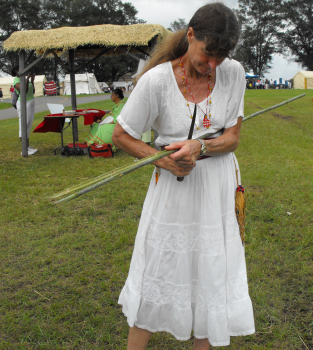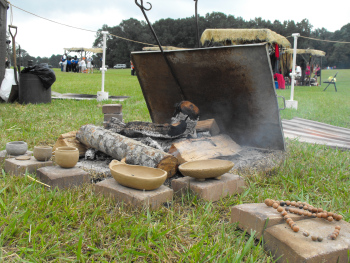
Cane baskets and pit-fired pottery
 We
also learned about two other intriguing Native American crafts at the
Moundville
festival --- cane baskets and pit-fired pottery. The
lady on the right is splitting a piece of river cane (a native bamboo)
in half, then in half again. Next, she will shave the top off
each quarter to make a strong, slender cane perfect for basket-weaving.
We
also learned about two other intriguing Native American crafts at the
Moundville
festival --- cane baskets and pit-fired pottery. The
lady on the right is splitting a piece of river cane (a native bamboo)
in half, then in half again. Next, she will shave the top off
each quarter to make a strong, slender cane perfect for basket-weaving.
River cane used to be ubiquitous throughout the South, and Native
Americans put it to good use, turning the canes into baskets, spears,
shelters, and much more. I was inspired by the demonstration to
work harder at planting our own mini cane brake where the power line
cut creates an opening in our floodplain forest.
 Crowds
of school children pushed us onward, past the basket-weaver to the
pit-fired pottery demonstration. I took pottery classes in high
school and college and loved the feel of mud on my hands, but always
found the kiln infrastructure too daunting to try on my own.
Native Americans, of course, used simpler techniques than electric
kilns. Instead, they dug shallow pits about a foot deep, placed
pots on a mound in the center, and built a fire around the edges.
The fire starts small, but is slowly allowed to engulf the pots over
the course of five to six hours, turning the pots first black then back
to clay color. Again, I resolved to try to mine a bit of the clay
along our creekbank and give pit-firing a shot.
Crowds
of school children pushed us onward, past the basket-weaver to the
pit-fired pottery demonstration. I took pottery classes in high
school and college and loved the feel of mud on my hands, but always
found the kiln infrastructure too daunting to try on my own.
Native Americans, of course, used simpler techniques than electric
kilns. Instead, they dug shallow pits about a foot deep, placed
pots on a mound in the center, and built a fire around the edges.
The fire starts small, but is slowly allowed to engulf the pots over
the course of five to six hours, turning the pots first black then back
to clay color. Again, I resolved to try to mine a bit of the clay
along our creekbank and give pit-firing a shot.
This post is part of our Moundville and Cruise to Mexico honeymoon
series.
Read all of the entries:
|
Want more in-depth information? Browse through our books.
Or explore more posts by date or by subject.
About us: Anna Hess and Mark Hamilton spent over a decade living self-sufficiently in the mountains of Virginia before moving north to start over from scratch in the foothills of Ohio. They've experimented with permaculture, no-till gardening, trailersteading, home-based microbusinesses and much more, writing about their adventures in both blogs and books.
Want to be notified when new comments are posted on this page? Click on the RSS button after you add a comment to subscribe to the comment feed, or simply check the box beside "email replies to me" while writing your comment.
